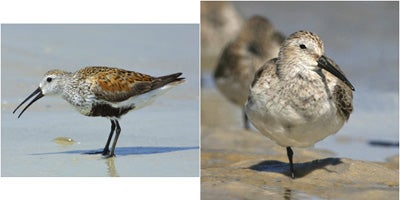SCIENTIFIC NAME:
Calidris alpina
OTHER NAMES:
Black-bellied sandpiper
STATUS:
Common in winter, spring, and fall, and occasional in early summer in Gulf Coast regions. In Tennessee Valley, common in fall, and fairly common in spring and winter. In Inland Coastal Plain, uncommon in fall, and rare in winter and spring. In Mountain region, uncommon in fall, and occasional in winter and spring. Low Conservation Concern.
DESCRIPTION:
Dunlin are medium sized shorebirds between six and nine inches in length with a wingspan of about fifteen inches. The bill and legs are relatively long and black. The bill has a noticeable droop near its end. Birds have different breeding and nonbreeding plumages. In breeding plumage the dunlin is reddish-brown on its back and crown with dark streaking on the back and upperparts. Under parts are white but the belly has a distinct large black patch. In winter dunlins are nondescript grayish brown on top, whitish underneath but slightly darker on the chest. In winter the black belly patch is absent. In flight, a white wingbar is noticeable in all plumages. Sexes are similar.
DISTRIBUTION:
Dunlin breed in the extreme northern portions of North America, Europe, and Asia. Many North American birds winter along the Pacific coast from southern Alaska to Baja California. Atlantic coast birds winter from Massachusetts to Florida then west along the Gulf coast down into the Yucatan Peninsula. European and Asian birds migrate to wintering grounds in southern Europe and southern Asia. Birds also winter in northern Africa. Breeding birds in western Alaska may winter in Asia.
HABITAT:
Dunlin inhabit the tundra while on their breeding grounds. Wintering habitat is primarily mudflats and shorelines.
FEEDING HABITS:
Dunlin probe mud, water and wet sand for prey items. During breeding range, dunlins feed mainly on insect larvae. Winter food items include marine worms, crustaceans, insects, and other invertebrates.
LIFE HISTORY AND ECOLOGY:
Migrating dunlin and wintering birds often form large flocks ranging from hundreds to thousands of birds. Nesting begins in late May and early June. Four eggs are laid in a ground nest defined by leaves or other vegetation. Both sexes incubate the eggs which hatch after three weeks. Young are precocial, covered with down at time of hatching and are mobile soon thereafter. Nestlings fledge at about twenty-five days of age. Population is considered abundant throughout its range.
REFERENCES:
Imhof, Thomas, A. 1976. Alabama Birds, 2nd ed. University of Alabama Press, Tuscaloosa, Ala.
NatureServe. 2006. NatureServe Explorer: An online encyclopedia of life [web application]. Version 4.7. NatureServe, Arlington, Virginia. Available http://www.natureserve.org/explorer.
Terres, John K. 1980. Audubon Society Encyclopedia of North American Birds. Alfred A. Knoph, New York.
Author:
Roger Clay, Wildlife Biologist, Division of Wildlife & Freshwater Fisheries






